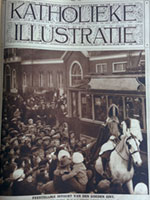Schenkmans Piet damaged Sinterklaas
dinsdag 19 november 2019 om 23:43

[ This article in Nederlands ]
‘Zwarte Piet’ is tradition and tradition must be preserved,’ is what some people say in our country.
I wondered what that tradition looked like over the centuries. And I searched old newspapers, religious almanacs and books with folk customs for information about the Saint Nicholas feast.
Guess what? ‘Zwarte Piet’ did not exist as a "Black-face" caricature before 1850.
The knowledge, to know that this tradition did not exist before 1850, could be comfortable for the people who say ‘This is tradition, we must hold on to this.’ It seemed comfortable to me to find out what this tradition actually looked like: diffuse. The Winter figures, which appeared in various European traditions and folk tales, initially alone, later as companion of Saint Nicholas, had some common denominators, such as soot, ashes of fire, fear and overcoming fear.
Our Geuzen already disapproved of the Sinterklaas feast, because they were "pagan, papal remains." And the Spanish (!) (Who did the Geuzen fight against?) costume or 'moorish appearance' was not even there at the time.
There are enough starting points to choose any Piet whatsoever —anything but this 'Black-face' caricature that replaced our original 'Pete' after 1850— from the diffuse traditions of before 1850: Sooty Pete, Masked Pete, Painted Pete, Ghost Pete, Clown Pete.
Feel free to read all sources which have brought me to this conclusion.
Research in language, cult and folklore
What did the color black have to do with winter?
In ancient and pre-Christian Europe, black was the color of mourning and death. "Ater" in Latin does not only mean black, but also ominous. The word is related to "atrocity". Black was the color of the underworld, of devils and demons.
The Slavic people knew the black Chernobog. In Scandinavian folklore, the black ‘Draug’ existed before the year 1000. They were the dead who escaped from their graves. Blackened under the influence of decomposition, they harassed the living with their supernatural powers.
The living could appease the dead with rituals. To begin with the funeral of the deceased himself. In the report of Ibn Fadlan from 921 we read how the Volga Vikings dress their — blackened — dead captain a few weeks after his death, in Byzantine side with golden knots, to burn him — surrounded by food, a dead dog, a chopped up horse and a brutally murdered girl — together with his ship.
Traditions like this disappeared under the influence of Christianity.
Fortunately — if I may say so.
Winter and feasts for the dead
However, the Feasts for the Dead still existed for centuries around the transition to winter. The time when, according to folk tales, the spirits could invade the world of the living. Food was put at doorsteps to appease the roaming dead. Young people paraded in processions through villages wearing masks, painted or blackened faces faces.
Such parades existed throughout Europe and survived the end of the Middle Ages. Groups of youngsters dressed up as Bogeyman-like figures, paraded in the streets, begging for food, on holy days like St. Martins day or Krampus night. In the Netherlands, according to religious almanacs from 1700, from November to Epiphany in January. The British Isles were familiar with the tradition of Mummers and Guisers during this season, that can be traced back to 1296. In Paris these parades took place on Saint Nicholas' name day reports a French book in 1843. It specifically mentions that the procession with youngsters dressed as satyrs and devils was curtailed in 1525.
Even in the work of the American writer Isaac Bashevis Singer, a ‘demon black as soot’ appears in an old Polish folk tale that his mother told him as a child.
Today we find traces of these traditions all over the world. In Halloween, in Día de Muertos, in Saint Martin's day, in Sinterklaas, New Year's Eve. Probably also in Up Helly Aa — and I undoubtedly didn't mention them all. Older components get new meanings over the years. In some festivals, eras or locations, the emphasis is more on warding off evil spirits, in the others more on sharing food in poor winter times.
Teacher Schenkman
In 1850 the picture book of schoolmaster Schenkman gives a new twist to the old Dutch Sint Nicolaasfeest. His Sinterklaas became a bit friendlier than he was before and he replaced the helper, who occured with Sinterklaas in some areas. With this, the youngsters who went from door to door, with sooty faces or masks, or being absurdly dressed and making weird moves, got a new role.
The helpers and callers, who locally had their own appearance and name, made way for ‘Zwarte Piet.’ A figure that appeared in every new edition of his book more and more like (caricature images of) an African slave or Moorish page. While large gold earrings, afro-style wigs, red lipstick and full blackface makeup cannot be found in Sinterklaas-publications older than 1850. That is to say: I have not been able to find them in recent years and would like to hear if you know of any original, proven old text in Newspapers, Almanacs or Books that would prove otherwise.
Blackface and Minstrel shows in the US
Historian Lise Koning argues in her research into Black Pete that Schenkman's Pete is related to the Black-face stage of the racist Minstrel shows from the United States. Her article is convincing: it is unlikely that Schenkman was not aware of these caricatures when he rewrote our Sinterklaas story, and added a caricature that resembled this theater form in many aspects.
I would like to add (August 14, 2020) to Koning's argument that the resemblance with the Minstrel shows has also struck me in the history of Black (play) Dolls. This history also shows racist caricatures, that have a striking resemblance with the figures in the Minstrel shows on the one hand and Schenkmans Zwarte Piet on the other.
It is without doubt Schenkmans book started a trend that meets with protests today. Well: since 1930 already.
Bullying and other excesses
I have seen and heard the excesses of Schenkman's trend in the schoolyard: school-parent-council-members, often prominent in a school, were allowed to say to a little boy with a Surinamese grandparent 'You don't have to paint your face, because you're already black.' For me at that time, reason to look for another school for the youngest daughter: neither the SPC-member nor the headmaster could be addressed against. Response from headmaster: Yes, that [MR member] is the target group of our school. Great, thanks: apparently I don't belong to your target group. Bye!
Even today, my daughter's girlfriends are being called names: "Zwarte Piet". Fortunately, my daughter's school punishes such behaviour.
This kind of behaviour has no resemblance whatsoever with "a children's festival". This behaviour will simply damage that entire festival. After all, it excludes certain children from the party mood.
Perhaps we — like Schenkman did? — find the original Bogeyman figures that were intertwined with the December festivals too creepy. Perhaps we prefer to see our ‘Good Saint’ in the company of 'funny comedians,' rather than demons, satyrs or living dead. Fun: exactly. So there is no excuse for perpetuating a racist tradition. We should stop following the path Schenkman took in 1850.
Search and find in European folklore: plenty of alternatives
European folklore is rich enough to draw on a multitude of winter Bogeyman figures. Many old publications mention soot, as you can read in the references. Soot from the bonfires that to ward off evil spirits, soot from hell, soot from the chimney. So, dust off the original winter Bogeyman, search in old engravings , prints and stories and choose — together — another figure.
That will benefit the entire Sinterklaas party.
[ Summary: The ‘Zwarte Piet’ character that looks like a black-face/Minstrel-show-figure, did not occur until 1850. European folklore contains enough medieval narratives to compile a beautiful new, older ‘Zwarte Piet’ — or whatever you want to call him. In fact, the tradition has always been subject to change. ]



